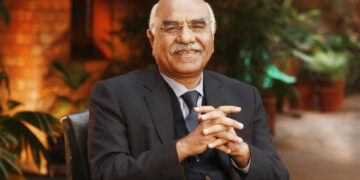 Stretching everyday concepts to their limits can be astonishingly productive for the insights they may provide by forcing us to search for answers to the paradoxes that may arise.A friendly warning: this column, though not injurious to your mental health, may be a difficult read. So why inflict it on readers?I seek your indulgence on two counts. First, science for me has been one lifelong love affair; and I find it immensely satisfying to share with and communicate to others this passion. Also, one needs a break now and then from that comparatively mundane and boring business of writing on political and social matters.
Stretching everyday concepts to their limits can be astonishingly productive for the insights they may provide by forcing us to search for answers to the paradoxes that may arise.A friendly warning: this column, though not injurious to your mental health, may be a difficult read. So why inflict it on readers?I seek your indulgence on two counts. First, science for me has been one lifelong love affair; and I find it immensely satisfying to share with and communicate to others this passion. Also, one needs a break now and then from that comparatively mundane and boring business of writing on political and social matters.
Secondly, if the column really does prove difficult to read, then spare a sympathetic thought for the time and effort I have spent in trying to present possibly difficult and abstruse scientific concepts in hopefully simple enough language for the average reader to comprehend. Einstein’s forthright advice to those like me planning such an exercise — “keep it simple but don’t simplify” — is fiendishly hard to implement.The subject on my mind today is the difficulties and paradoxes that arise when we stretch those invaluable thinking tools of reason and logic to their ultimate limits. And yet, we have no choice but to engage with the ensuing problems. For, even the conclusion that reason and logic may either be insufficient or inappropriate tools in certain circumstances is itself a decision based on reason and logic. For us humans, there is no escape from this mental bondage, regardless of the touted claims for intuition and Ilm-al-Ghaib (the knowledge of the unseen). Indeed, that last observation is itself an example of what I said in the first sentence of this paragraph.
But enough of abstractions; let’s get on with some flesh and blood examples of what I mean. And what could be better than starting with one of those famous and well-known paradoxes about motion, space, and time as we envision them, first proposed by Zeno the Greek some 3,000 years ago?In the one known as the paradox of Achilles and the tortoise, he argued as follows: if you want to get from point A to point B, you first have to get a point C half-way between the two; but before you can arrive at point C you must get to a point D half-way between point A and C; but before you can reach this point D you must first arrive at a point E half-way between D and A etc, etc, etc; as it should be obvious to you by now, you can go on and on and on and on with this argument endlessly. Effectively, this means you can never reach B (question: can you even start your journey?).
Is the logic and reasoning not impeccable? It certainly is. And, for all the attempts of the finest minds over the following millennia, no one could adequately refute Zeno. It is only in the last 150 years or so that mathematicians have been able to provide a satisfactory explanation of how and why the paradox arises.In the normal course of things, mathematics is a wonderful tool for understanding and describing nature. But we must never forget that it is based on certain fundamental hypotheses (‘axioms’) that may well breakdown when dealing with extreme cases (without going into the technical details, let me tell you we did not even have, until some 100 years ago, a rigorously satisfactory definition of what exactly is meant by ‘a number’ — any number, such as ‘one’ or ‘three’. And yet everyone knows how to use numbers).
What Zeno’s paradox exploits are the assumptions (natural and normal in ordinary circumstances) that ‘time’ and ‘space’ are divisible quantities. But are they ‘infinitely’ divisible? And what exactly do we mean by words such as ‘infinite’? It took till the late 19th century for mathematicians such as Cantor and Weierstrass to finally show that the mathematics of the ‘infinite’ is quite different and paradoxical from standard mathematics (e.g. if we define ‘a point’ as not taking up any space — so that there are an infinite number of points in any line — then there must by definition be also an infinite number of points in half of the same line. Does that mean a part is equal to the whole?).
So, stretching everyday concepts to their limits can be astonishingly productive for the insights they may provide by forcing us to search for answers to the paradoxes that may arise. The best modern example is Einstein’s Theory of Relativity. Is it not commonsense and our everyday experience that motion is a relative matter (the earth is whizzing around the sun, but we moving along with the earth have no sensation of it), and that whatever be the speed of motion of anything, in principle there is no intrinsic or theoretical reason why that thing cannot be made to move a little faster, given an additional external impetus? But then how does one explain those stubborn scientific facts about light that seem to contradict these assumptions?
Einstein boldly decided to accept nature, as is. He postulated that it just is a fact of nature that light alone will always be measured to travel at the same fixed speed regardless of how any observer measuring it is himself moving. And also, that the velocity of light is the cosmic speed limit that no object can reach let alone exceed. These assumptions in turn forced him into re-configuring the very nature of ‘time’ and ‘space’ as conventionally understood, with far reaching consequences.
And yet, Einstein’s masterly Theory of Gravitation and Space-time itself seems to breakdown when stretched to the limits (as applied to the Big Bang Theory of the origin of our universe). The universe is observed to be expanding with time at a calculable rate. Now mentally run the clock backwards. It can be calculated that the result would be the eventual shrinking to a virtual point of the whole universe (and all that it contains) roughly 15 billion years ago (incidentally, all this is not merely fancy conjecture but well supported by impressive evidence). But what exactly is this mysterious initial point where it all started (physicists call it a ‘singularity’)?
Einstein’s theory co-joins mass with that mysterious but evidentiary real union of ‘space’ and ‘time’ we know as the single entity ‘space-time’. John Wheeler has memorably described this linkage as “mass grips space-time and tells it how to bend; space-time grips mass and tells it how to move”. A magnificent theory again breaks down here because at the ‘singularity’ the squashed mass must be ‘infinitely’ concentrated and create an ‘infinitely’ warped space-time around it, where ‘space’ is crushed out of existence and ‘time’ comes to a standstill and has no meaning. But we have no idea (beyond what is forced upon us by theory) what all this could possibly mean.
In man’s relentless quest to understand at a fundamental level what his world and this universe is all about, of what and how it is built, and what makes it tick, he has created some magnificent theories, none more impressive than the three great ‘field’ theories of the 20th century (Einstein’s theory of gravitation, the theory of the interaction between light and charged particles, known as quantum electro-dynamics, and ‘string’ theory that seeks to unify the other two, so far without success). But given their difficulties with ‘infinities’, must we dig even deeper for the ‘truth’?
Here, more and more, we are beginning to appreciate the fundamental role of geometry, and two of its concepts, ‘symmetry’ and ‘invariance’. The law of conservation of momentum is not ‘really’ a law but the natural consequence of the fact that in space-time there is no preferred direction in space. The same applies to the law of conservation of energy: it is the natural consequence of the fact that there is no preferred instant of time. And, as the great French geometer Élie Cartan showed, Einstein’s Theory of Gravitation follows from the geometrical principle that ‘the boundary of a boundary is zero’ (Sorry! It is far too complicated to explain that here). – Dailytimes – Munir Attaullah












